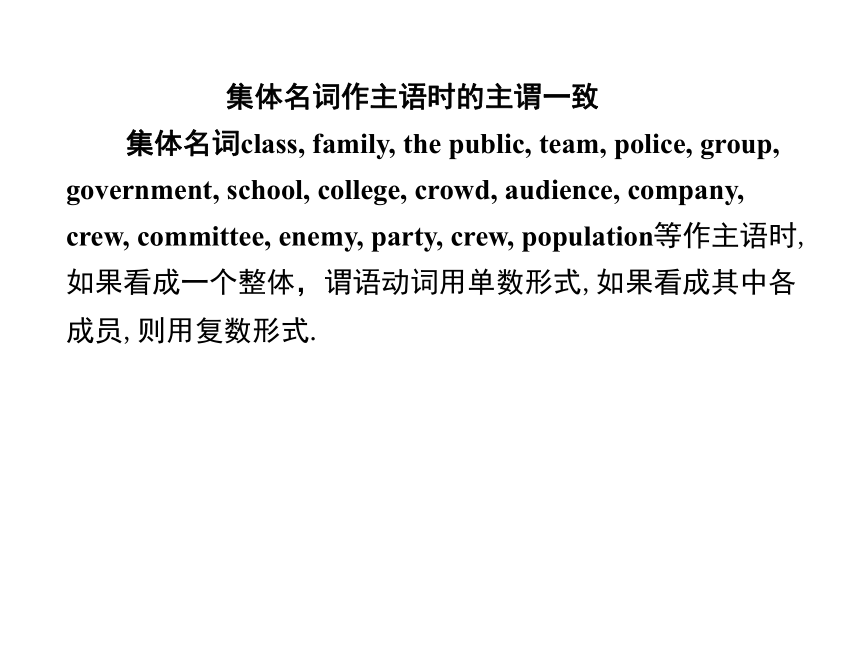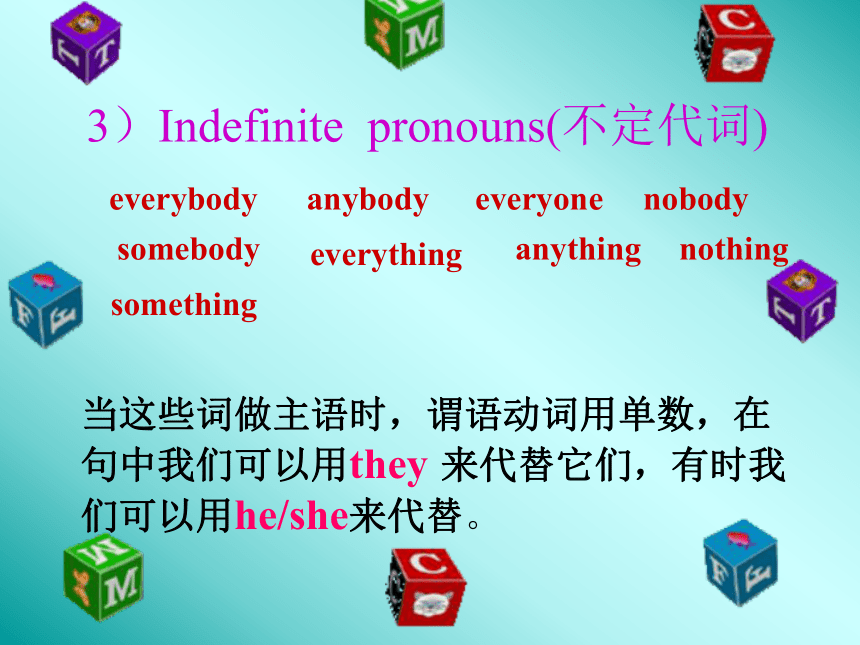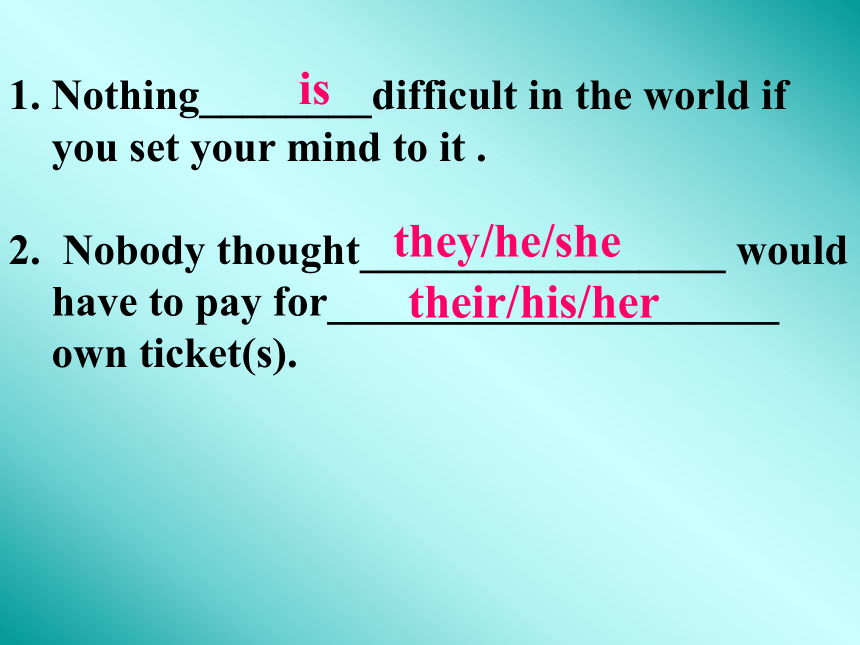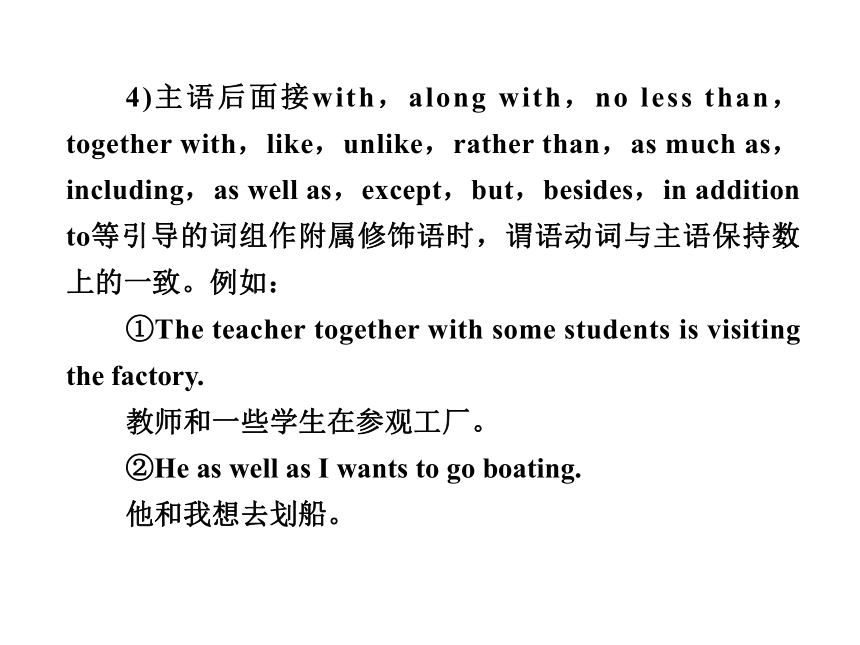人教新课标必修4课件:Unit1 Women of achievement grammar(共28张PPT)
文档属性
| 名称 | 人教新课标必修4课件:Unit1 Women of achievement grammar(共28张PPT) |  | |
| 格式 | zip | ||
| 文件大小 | 409.0KB | ||
| 资源类型 | 教案 | ||
| 版本资源 | 人教版(新课程标准) | ||
| 科目 | 英语 | ||
| 更新时间 | 2020-04-21 17:08:02 | ||
图片预览









文档简介
课件28张PPT。 W E L C O M E 集体名词作主语时的主谓一致
集体名词class, family, the public, team, police, group, government, school, college, crowd, audience, company, crew, committee, enemy, party, crew, population等作主语时,如果看成一个整体,谓语动词用单数形式,如果看成其中各成员,则用复数形式.
advertising(广告),travel/traveling(旅行),clothing(服装), luggage(行李),furniture(家具)等表示类别的集合名词作主语时,谓语动词采用单数形式。例如:
①I've just been informed that my luggage has just arrived.
我刚接到通知说我的行李已经运到了。
②Advertising is one of the biggest businesses in America.
广告是美国最大的行业之一。everybody当这些词做主语时,谓语动词用单数,在句中我们可以用they 来代替它们,有时我们可以用he/she来代替。anybodyeveryonenobodysomebody
everythinganythingnothingsomething
3)Indefinite pronouns(不定代词)
Nothing________difficult in the world if you set your mind to it .
2. Nobody thought_________________ would have to pay for_____________________ own ticket(s).they/he/shetheir/his/heris4)主语后面接with,along with,no less than,together with,like,unlike,rather than,as much as,including,as well as,except,but,besides,in addition to等引导的词组作附属修饰语时,谓语动词与主语保持数上的一致。例如:
①The teacher together with some students is visiting the factory.
教师和一些学生在参观工厂。
②He as well as I wants to go boating.
他和我想去划船。5)由and,both...and连接的两个名词或代词作主语时,如果表示的人或物是不同的,或表示其他不同的观念时,谓语动词用复数。如果表示的是同一人或物、同一观念时,谓语动词用单数形式。
①Reading and writing are very important.
读写很重要。
②The professor and writer is to come to the meeting.
那位教授兼作家要来参加会议。a singer and dancer
The singer and dancer _____ on the stage.isThe gift is used to have western meals.
What is it?a knife and forkA knife and fork is used to have meals.6)两个并列的名词前如果有each, every, no, many a等修饰时,谓语动词采用单数形式。例如:
①Each student and each teacher was given a ticket.
每个学生和老师都发了一张票。
②Many a boy likes playing football.
许多男孩喜欢踢足球。
③More than one year has passed.
一年多过二、语言意义一致原则:即主语意义上的单复数要与谓语的单复数形式一致。
1)表示总称意义的名词,如people,police,force, folk, beast, cattle, youth等作主语时,谓语动词用复数形式。例如:
①The cattle are in the shed.
牛在牛棚里。
②The police are searching for him.
警方正在寻找他。2)单复数形式相同的名词作主语,谓语动词应根据意义决定单复数。此类词常见的有:deer, fish, sheep, means, works, species, series, crossroads等。例如:
①The species of fish are numerous.
鱼的种类很多。
②This species of rose is very rare.
这种玫瑰很稀少。3)国名,地名,组织机构名称,书刊杂志名称,山名和水名等专有名词作主语时,谓语动词用单数。
①The United States was founded in 1776.
美国建立于1776年。
②The Arabian Nights is a book known to lovers of English.
《天方夜谭》是英语爱好者熟悉的一本书。4)“pair,piece,kind of+名词或代词” 作主语时,谓语动词与pair,piece,kind等词的形式保持一致,与of之后的名词或代词无关。常见的名词有trousers, glasses, gloves, shoes, slippers等。例如:
①Your trousers are so dirty that you should wash them at once.
你的裤子太脏了,你应该马上洗洗。
②Until now only one pair of glasses has been sold.
到目前为止,只卖出去一副眼镜。5)表示类别的the+形容词或分词;以复数形式出现的某些名词,如goods,clothes,glasses,shoes,trousers等作主语时,谓语动词用复数;但news,politics,physics,maths,plastics,works(工厂)等名词作主语时,谓语动词用单数;the+表抽象概念的形容词表示类别时,谓语动词用单数。例如:
①The beautiful is loved by all.
美好的事物大家都喜欢。
②The sick are well looked after here.
病人在这里得到很好的照顾。6)none of后面如果连接的是不可数名词,谓语动词用单数形式。如果后面接的是可数名词,则谓语动词既可用单数,也可用复数。例如:
①None of the telephones is/are working.
电话中没有一部不是坏的。
②None of the information about him has been received.
关于他的消息一点也没收到。neither of
none ofn. (U) n.(C)neither + n.(singl.) V. singl.
plural.How to use none and neitherV.(singl.)V.(singl.) A million dollars __(is/are) really a lot of money.
isSixty years a long time.
Three thousand miles a long distance.
Fifty kilogrammes not too heavy to be carried.
isisis7)主语为表示距离、时间、长度、价值、金额、重量等的复数名词时,谓语动词用单数形式。8)代词what, which, who, none, some, any, more, most, all等词的单复数由其指代的词的单复数决定。例如:
①All is right.
一切顺利。
②All are present.
人都到齐了。三、就近一致原则:即谓语动词的单复形式取决于最靠近它的词语。
1)由连词or;either...or...;neither...nor;not only...but (also)...;not...but;whether...or...连接并列主语时,谓语动词与最近的主语保持形式上一致。例如:
Bob _____ a worker.isMike and Bob _____ workers.areBoth Mike and Bob _______
workers.areNeither Mike nor Bob _______
a teacher.isNeither of them _______
(know) how to teach English. knows/knowNone of them ___________
(know) how to teach English. knows/know2)在here,there,such引导的倒装句中,谓语动词与其后的主语保持一致;如果主语是单数可数名词或不可数名词,谓语动词用单数;如果主语是多个并列主语,谓语动词与其最相邻的主语保持人称和数上的一致。例如:
①Here is a pen, a few envelops and some paper for you.
给你笔、信封和纸。
②Such are the fortunes of war.
这些就是战争的机会。3 There ----- a temple on the mountain.山顶有一座庙。lies注意:
在大多数情况下,主语与表语一致;如不一致,谓语动词与主语保持一致。例如:
①Tomatoes are a vegetable.
西红柿是一种蔬菜。
②The Chinese are a friendly people.
中华民族是个友好的民族。1.One or two days ____ enough to see the city.
A.is B.are
C.am D.be
2.Neither my wife nor I myself ____ able to persuade my daughter to change her mind.
A.is B.are
C.am D.beExercises:3.Not only I but also Jane and Mary ____ tired of having one examination after another.
A.is B.are
C.am D.be
4.Not the teacher,but the students ____ looking forward to seeing the film.
A.is B.are
C.am D.be
5.Nobody but Betty and Mary ____ late for class yesterday.
A.was B.were
C.has been D.have been
6.A woman with some children ____ soon.
A.is coming B.are coming
C.has come D.have come7.No one except my parents ____ anything about this.
A.know B.knows
C.is known D.are known
8.The teacher as well as the students ____ the book already.
A.has read B.have read
C.are reading D.is reading
9.All but one ____ in the accident.
A.was killed B.were killed
C.will be killed D.are killed
10. When and where to build the new factory ___ yet.
A. is not decided B. are not decided
C. has not decided D. have not decided 11. The number of people invited ___fifty, but a number of them ___ absent for different reasons.
A. were; was B. was; was
C. was; were D. were; were
12. ____ of the land in that district ____ covered with trees and grass.
A. Two fifth; is B. Two fifth; are
C. Two fifths; is D. Two fifths; are
集体名词class, family, the public, team, police, group, government, school, college, crowd, audience, company, crew, committee, enemy, party, crew, population等作主语时,如果看成一个整体,谓语动词用单数形式,如果看成其中各成员,则用复数形式.
advertising(广告),travel/traveling(旅行),clothing(服装), luggage(行李),furniture(家具)等表示类别的集合名词作主语时,谓语动词采用单数形式。例如:
①I've just been informed that my luggage has just arrived.
我刚接到通知说我的行李已经运到了。
②Advertising is one of the biggest businesses in America.
广告是美国最大的行业之一。everybody当这些词做主语时,谓语动词用单数,在句中我们可以用they 来代替它们,有时我们可以用he/she来代替。anybodyeveryonenobodysomebody
everythinganythingnothingsomething
3)Indefinite pronouns(不定代词)
Nothing________difficult in the world if you set your mind to it .
2. Nobody thought_________________ would have to pay for_____________________ own ticket(s).they/he/shetheir/his/heris4)主语后面接with,along with,no less than,together with,like,unlike,rather than,as much as,including,as well as,except,but,besides,in addition to等引导的词组作附属修饰语时,谓语动词与主语保持数上的一致。例如:
①The teacher together with some students is visiting the factory.
教师和一些学生在参观工厂。
②He as well as I wants to go boating.
他和我想去划船。5)由and,both...and连接的两个名词或代词作主语时,如果表示的人或物是不同的,或表示其他不同的观念时,谓语动词用复数。如果表示的是同一人或物、同一观念时,谓语动词用单数形式。
①Reading and writing are very important.
读写很重要。
②The professor and writer is to come to the meeting.
那位教授兼作家要来参加会议。a singer and dancer
The singer and dancer _____ on the stage.isThe gift is used to have western meals.
What is it?a knife and forkA knife and fork is used to have meals.6)两个并列的名词前如果有each, every, no, many a等修饰时,谓语动词采用单数形式。例如:
①Each student and each teacher was given a ticket.
每个学生和老师都发了一张票。
②Many a boy likes playing football.
许多男孩喜欢踢足球。
③More than one year has passed.
一年多过二、语言意义一致原则:即主语意义上的单复数要与谓语的单复数形式一致。
1)表示总称意义的名词,如people,police,force, folk, beast, cattle, youth等作主语时,谓语动词用复数形式。例如:
①The cattle are in the shed.
牛在牛棚里。
②The police are searching for him.
警方正在寻找他。2)单复数形式相同的名词作主语,谓语动词应根据意义决定单复数。此类词常见的有:deer, fish, sheep, means, works, species, series, crossroads等。例如:
①The species of fish are numerous.
鱼的种类很多。
②This species of rose is very rare.
这种玫瑰很稀少。3)国名,地名,组织机构名称,书刊杂志名称,山名和水名等专有名词作主语时,谓语动词用单数。
①The United States was founded in 1776.
美国建立于1776年。
②The Arabian Nights is a book known to lovers of English.
《天方夜谭》是英语爱好者熟悉的一本书。4)“pair,piece,kind of+名词或代词” 作主语时,谓语动词与pair,piece,kind等词的形式保持一致,与of之后的名词或代词无关。常见的名词有trousers, glasses, gloves, shoes, slippers等。例如:
①Your trousers are so dirty that you should wash them at once.
你的裤子太脏了,你应该马上洗洗。
②Until now only one pair of glasses has been sold.
到目前为止,只卖出去一副眼镜。5)表示类别的the+形容词或分词;以复数形式出现的某些名词,如goods,clothes,glasses,shoes,trousers等作主语时,谓语动词用复数;但news,politics,physics,maths,plastics,works(工厂)等名词作主语时,谓语动词用单数;the+表抽象概念的形容词表示类别时,谓语动词用单数。例如:
①The beautiful is loved by all.
美好的事物大家都喜欢。
②The sick are well looked after here.
病人在这里得到很好的照顾。6)none of后面如果连接的是不可数名词,谓语动词用单数形式。如果后面接的是可数名词,则谓语动词既可用单数,也可用复数。例如:
①None of the telephones is/are working.
电话中没有一部不是坏的。
②None of the information about him has been received.
关于他的消息一点也没收到。neither of
none ofn. (U) n.(C)neither + n.(singl.) V. singl.
plural.How to use none and neitherV.(singl.)V.(singl.) A million dollars __(is/are) really a lot of money.
isSixty years a long time.
Three thousand miles a long distance.
Fifty kilogrammes not too heavy to be carried.
isisis7)主语为表示距离、时间、长度、价值、金额、重量等的复数名词时,谓语动词用单数形式。8)代词what, which, who, none, some, any, more, most, all等词的单复数由其指代的词的单复数决定。例如:
①All is right.
一切顺利。
②All are present.
人都到齐了。三、就近一致原则:即谓语动词的单复形式取决于最靠近它的词语。
1)由连词or;either...or...;neither...nor;not only...but (also)...;not...but;whether...or...连接并列主语时,谓语动词与最近的主语保持形式上一致。例如:
Bob _____ a worker.isMike and Bob _____ workers.areBoth Mike and Bob _______
workers.areNeither Mike nor Bob _______
a teacher.isNeither of them _______
(know) how to teach English. knows/knowNone of them ___________
(know) how to teach English. knows/know2)在here,there,such引导的倒装句中,谓语动词与其后的主语保持一致;如果主语是单数可数名词或不可数名词,谓语动词用单数;如果主语是多个并列主语,谓语动词与其最相邻的主语保持人称和数上的一致。例如:
①Here is a pen, a few envelops and some paper for you.
给你笔、信封和纸。
②Such are the fortunes of war.
这些就是战争的机会。3 There ----- a temple on the mountain.山顶有一座庙。lies注意:
在大多数情况下,主语与表语一致;如不一致,谓语动词与主语保持一致。例如:
①Tomatoes are a vegetable.
西红柿是一种蔬菜。
②The Chinese are a friendly people.
中华民族是个友好的民族。1.One or two days ____ enough to see the city.
A.is B.are
C.am D.be
2.Neither my wife nor I myself ____ able to persuade my daughter to change her mind.
A.is B.are
C.am D.beExercises:3.Not only I but also Jane and Mary ____ tired of having one examination after another.
A.is B.are
C.am D.be
4.Not the teacher,but the students ____ looking forward to seeing the film.
A.is B.are
C.am D.be
5.Nobody but Betty and Mary ____ late for class yesterday.
A.was B.were
C.has been D.have been
6.A woman with some children ____ soon.
A.is coming B.are coming
C.has come D.have come7.No one except my parents ____ anything about this.
A.know B.knows
C.is known D.are known
8.The teacher as well as the students ____ the book already.
A.has read B.have read
C.are reading D.is reading
9.All but one ____ in the accident.
A.was killed B.were killed
C.will be killed D.are killed
10. When and where to build the new factory ___ yet.
A. is not decided B. are not decided
C. has not decided D. have not decided 11. The number of people invited ___fifty, but a number of them ___ absent for different reasons.
A. were; was B. was; was
C. was; were D. were; were
12. ____ of the land in that district ____ covered with trees and grass.
A. Two fifth; is B. Two fifth; are
C. Two fifths; is D. Two fifths; are
同课章节目录
